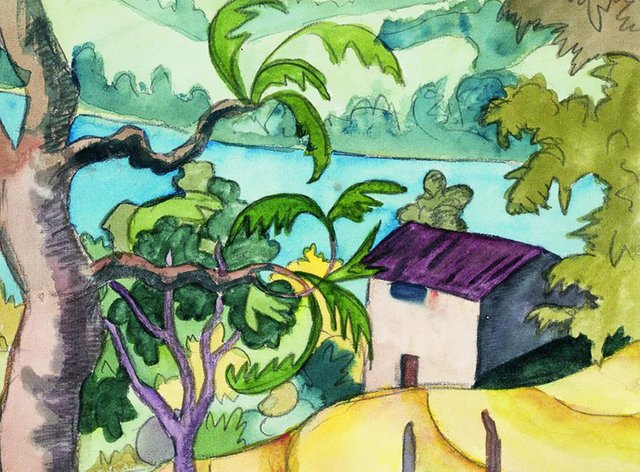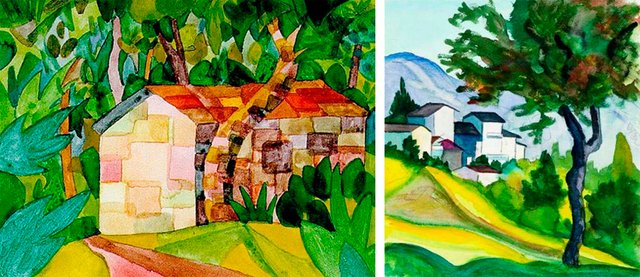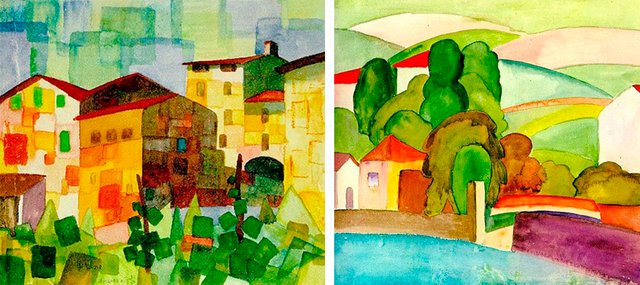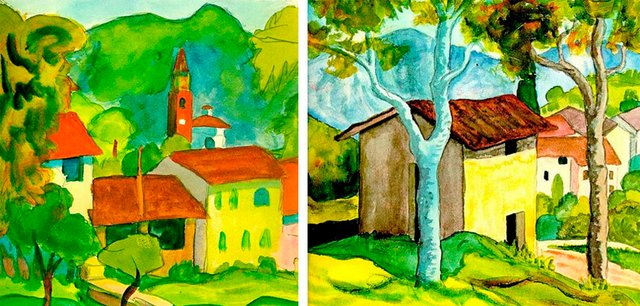Meeting the painter: Herman Hesse
Yes, it’s not a typo in the title. It’s definitely the painter. I was so surprised to learn all of a sudden, that Herman Hesse was not only a writer but painted these lovely sunny enchanting watercolors, enthusiastic hymns to the beauty of our world. Compare the mood with his writings (“The Glass Bead Game”, “Steppenwolf” and others) – it is quite a different story! I was so amazed that I have never heard about him as a painter that I can’t help sharing this discovery with others.
Да, это не опечатка в заголовке. Именнно с художником. Я сама была внезапно удивлена узнать, что Герман Гессе был не только писателем, но и рисовал на мой вкус прекрасные, солнечные, волшебные акварели, являющиеся восторженным гимном красоте нашего мира. Сравните настроение с его писательским творчеством («Игра в Бисер», «Степной Волк» и др.) - совсем история о разном! Меня настолько удивило, что я до сих пор ничего не знала о нем, как о художнике, что я не могу не поделиться этим открытием с миром.

Hesse started painting when he was 40 and got deeply engrossed. He wrote about his new interest sometimes in a joking manner, that finally, his fingers are not black, as after writing, but multi-colored; and sometimes in a serious tone, affirming that it is the practice of painting that saved him and helped him come out of a difficult period in his life.
Гессе начал рисовать, когда ему было 40, и увлекся с головой. Сам он писал об этом новом увлечении, то шутя, что наконец-то пальцы у него не черные, как после писательского труда, а цветные, то очень глубоко и серьезно, подчеркивая, что именно опыт рисования спас его в трудный период жизни, помог выстоять.

Drawing and painting for Hesse were a different niche from writing. He painted a perfect world full of light, happiness, and beauty. This was the place where he used to escape from his melancholy and the feeling of despair. In his autobiographical novel, which is full of mystifications, he included a symbolic episode, where he is being held in prison and is painting huge landscape scene on the wall full of everything he loved so much — mountains, rivers, sea and clouds… and a small train departing into the landscape. At the end of the episode when the jailers come Hesse decreases in size, steps into the picture and rides this small train into his wonderful world.
Рисование и живопись для Гессе занимало совсем другую нишу, чем писательство. Рисуя, он отображал идеальный мир, полный света, радости и красоты. Это тот мир, куда он сбегал от своей тоски и ощущения безысходности. В своем «Кратком жизнеописании», которое полно мистификаций, он описывал символический эпизод, где он сидя в тюрьме рисует на тюремной стене огромный пейзаж, наполненный тем, что он так любит - горами, реками, морем и облаками… и маленьким поездом уходящим вглубь пейзажа. В конце эпизода, когда приходят тюремщики, Гессе уменьшается в размерах, входит в картину и уезжает на своем маленьком поезде в свой прекрасный мир.

Although Hesse considered himself an amateur in painting, and his works has gone practically unnoticed by society, looking at his watercolors brings me real pleasure. The simplicity of forms and clean color fills — all reminds me a bit of the works of Gauguin — song of his tropical paradise, only Hesse’s palette is more sunny, clean and airy. And of course, in all these works there is a note of childishness, and it always impresses me in paintings. Indeed as Picasso once said: “Every child is an artist. The difficulty is to remain an artist coming out of childhood.”
И хотя сам Гессе считал себя дилетантом в плане живописи, а общество оставило этот его труд не особо замеченным, мне просмотр его акварелей доставил истинное удовольствие. Простота форм, лаконичные заливки цвета - все это мне немного напомнило мне работы Гогена - песнь о его тропическом рае, только палитра более солнечная, чистая и воздушная. И конечно, во всех этих работах есть нотка детскости, и это всегда меня подкупает в живописных работах, ведь как говорил Пикассо: “Каждый ребенок — художник. Трудность в том, чтобы остаться художником, выйдя из детского возраста.”

I love the paintings in which there are no deep meaning, but pure enjoyment of beauty that you see with the heart. A play of combinations of Naples yellow, Prussian blue and cobalt is so great in itself that the simple landscapes of trees and houses are filled with the incredible energy of life.
Enjoy!
Я люблю работы, в которых нет никакого глубинного смысла, кроме чистого наслаждения красотой, которую ты видишь сердцем. Игра сочетаний неаполитанской желтой, берлинской лазури и кобальта - разве само это не прекрасно настолько, что простые сюжеты из деревьев и домиков наполняются невероятной энергией жизни?
Наслаждайтесь!
(All illustrations used in the article are painted by Hermann Hesse)
Спасибо! Для меня это тоже открытие!